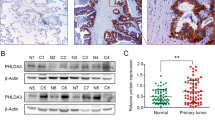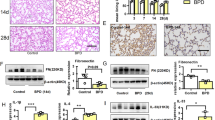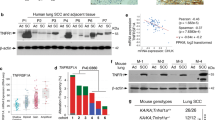Abstract
The extracellular matrix glycoprotein, fibronectin, influences a variety of cellular functions including adhesion, migration, survival, differentiation, and growth. Fibronectin has also been shown to increase the migration and proliferation of human lung carcinoma cells. However, the role of fibronectin in controlling lung airway epithelial cell phenotype remains unknown. Here, we demonstrate that fibronectin stimulates the proliferation of human bronchial epithelial cells (BEAS-2B and 16-HBE). Of note, fibronectin induced the mRNA and protein expression of c-Myc and cyclin D1, while it decreased the expressions of cyclin-dependent kinase inhibitor p21 WAF-1/CIP1/MDA-6 (p21) and the tumor suppressor gene phosphatase and tensin homolog deleted on chromosome ten (PTEN). Fibronectin also stimulated the phosphorylation of the phosphatidylinositol 3 kinase (PI3-K) downstream signal Akt. The inhibitor of PI3-K, Wortmannin, and anti-α5β1 integrin antibodies abrogated the effect of fibronectin on c-Myc, cyclin D1, p21, and PTEN expression. The stimulatory effect of fibronectin was mediated by nuclear factor kappaB (NF-κB) since fibronectin induced the expression of the p65 component of NF-κB and enhanced NF-κB DNA binding. Furthermore, we found that p65 small interfering RNA inhibited the effect of fibronectin on c-Myc, cyclin D1, p21, PTEN expression, and on fibronectin-induced cell proliferation. Finally, we found that fibronectin inhibits apoptosis by reducing DNA fragmentation and inhibiting the activities of caspases 3/7. Taken together, our findings demonstrate that fibronectin stimulates human bronchial epithelial cell growth and inhibits apoptosis through activation of NF-κB, which, in turn, increases the expression of c-Myc and cyclin D1 and decreases p21 and PTEN via α5β1 integrin-dependent signals that include PI3-K/Akt. Therefore, alternations in the extracellular matrix composition of the lung, with increased fibronectin, might promote epithelial cell growth and thereby contribute to oncogenesis in certain settings.
This is a preview of subscription content, access via your institution
Access options
Subscribe to this journal
Receive 50 print issues and online access
$259.00 per year
only $5.18 per issue
Buy this article
- Purchase on Springer Link
- Instant access to full article PDF
Prices may be subject to local taxes which are calculated during checkout





Similar content being viewed by others
References
Akiyama SK, Yamada SS, Chen WT, Yamada KM . (1989). J Cell Biol 109: 863–875.
Alexandrova A, Ivanov A, Chumakov P, Kopnin B, Vasiliev J . (2000). Oncogene 19: 5826–5830.
Amati B, Alevizopoulos K, Vlach J . (1998). Front Biosci 3: d250–d268.
Aoshiba K, Rennard SI, Spurzem JR . (1997). Am J Physiol 273: L684–L693.
Arcuri C, Bianchi R, Brozzi F, Donato R . (2005). J Biol Chem 280: 4402–4414.
Asano T, Yao Y . (2004). Oncogene 23: 8571–8580.
Benaud CM, Dickson RB . (2001). Oncogene 20: 759–768.
Braun-Dullaeus RC, Mann MJ . (2001). Arterioscler Thromb Vasc Biol 21: 1152–1158.
Chen F, Lu Y . (2001). J Biol Chem 276: 11414–11419.
Cordes N, Beinke C . (2004). Cancer Biol Ther 3: 47–53.
Cordes N, van Beuningen D . (2003). Br J Cancer 88: 1470–1479.
Cordes N, van Beuningen D . (2004). Int J Radiat Oncol Biol Phys 58: 453–462.
Dai R, Iwama A, Wang S, Kapila YL . (2005). Apoptosis 10: 503–512.
Danen EH, Sonneveld P, Sonnenberg A, Yamada KM . (2000). J Cell Biol 151: 1413–1422.
de Jong-Hesse Y, Kampmeier J, Lang GK, Lang GE . (2005). Graefes Arch Clin Exp Ophthalmol 243: 695–700.
de la Fuente MT, Casanova B, Garcia-Gila M, Silva A, Garcia-Pardo A . (1999). Leukemia 13: 266–274.
Dignam JD, Lebovitz RM, Roeder RG . (1983). Nucleic Acids Res 11: 1475–1489.
Galmozzi E, Casalini P . (2004). J Cell Physiol 200: 82–88.
Gao N, Flynn DC, Zhang Z, Zhong XS, Walker V, Liu KJ (2004). Am J Physiol Cell Physiol 287: C281–C291.
Garl PJ, Wenzlau JM, Walker HA, Whitelock JM, Costell M, Weiser-Evans MC . (2004). Circ Res 94: 175–183.
Gordon AH, O’Keefe RJ . (2005). Cancer Res 65: 3209–3217.
Halder SK, Beauchamp RD, Datta PK . (2005). Exp Cell Res 307: 231–246.
Han S, Sidell N . (2003). J Clin Endocrinol Metab 88: 713–719.
Han S, Sidell N, Roman J . (2005). Cancer Lett 219: 71–81.
Han S, Sidell N, Susan Roser-Pager S, Roman J . (2004). Int J Cancer 111: 322–331.
Han SW, Lei ZM, Rao CV . (1996). Endocrinology 137: 1791–1797.
Illario M, Cavallo AL, Monaco S, Di Vito E, Mueller F, Marzano LA et al. (2005). J Clin Endocrinol Metab 90: 2865–2873.
Jin Z, Gao F, Flagg T, Deng X . (2004). J Biol Chem 279: 40209–40219.
Kijima T, Maulik G, Ma PC, Madhiwala P, Schaefer E, Salgia R . (2003). J Cell Mol Med 7: 157–164.
Landowski TH, Olashaw NE . (2003). Oncogene 22: 2417–2421.
Liu B, Itoh H, Louie O, Kubota K, Kent KC . (2004). J Surg Res 120: 256–265.
Loeser RF . (2002). Biorheology 39: 119–124.
Moon SK, Kim HM, Kim CH . (2004). Arch Biochem Biophys 421: 267–276.
Nasu-Tada K, Koizumi S, Inoue K . (2005). Glia 52: 98–107.
Orend G, Huang W, Olayioye MA, Hynes NE, Chiquet-Ehrismann R, Tenascin C . (2003). Oncogene 22: 3917–3926.
Pulai JI, Chen H . (2005). J Immunol 174: 5781–5788.
Rajabi HN, Baluchamy S, Kolli S, Nag A, Srinivas R, Raychaudhuri P et al. (2005). J Biol Chem 280: 361–374.
Sansal I, Sellers WR . (2004). J Clin Oncol 22: 2954–2963.
Suh J, Rabson AB . (2004). J Cell Biochem 91: 100–117.
Takizawa H, Beckmann JD, Yoshida M, Romberger D, Rennard SI . (1991). Am J Resp Cell Mol Biol 5: 548–555.
Tamura M, Gu J, Matsumoto K, Aota S, Parsons R, Yamada KM . (1998). Science 280: 1614–1617.
Tang CH, Yang RS, Huang TH, Liu SH, Fu WM . (2004). Mol Pharmacol 66: 440–449.
Tell G, Pines A, Arturi F, Cesaratto L, Adamson E, Puppin C et al. (2004). Endocrinology 145: 4660–4666.
Vignola AM, Chiappara G . (2001). J Allergy Clin Immunol 108: 738–746.
Wadsworth SJ, Freyer AM, Corteling RL, Hall IP . (2004). Am J Physiol Lung Cell Mol Physiol 286: L596–L603.
Wang A, Yokosaki Y, Ferrando R, Balmes J, Sheppard D . (1996). Am J Resp Cell Mol Biol 15: 664–672.
Wu JT, Kral JG . (2005). J Surg Res 123: 158–169.
Zhang F, Li C, Halfter H, Liu J . (2003). Oncogene 22: 894–905.
Zhao YL, Piao CQ, Hei TK . (2002). Br J Cancer 86: 1923–1928.
Acknowledgements
We are thankful to Dr Shi-Yong Sun (Department of Hematology/Oncology at Emory University) for providing BEAS-2B cells. This work was supported by American Lung Association Bioresearch Grant RG-10215-N (SWH) and by a Merit Review Grant from the Department of Veterans Affairs (JR).
Author information
Authors and Affiliations
Corresponding author
Rights and permissions
About this article
Cite this article
Han, S., Roman, J. Fibronectin induces cell proliferation and inhibits apoptosis in human bronchial epithelial cells: pro-oncogenic effects mediated by PI3-kinase and NF-κB. Oncogene 25, 4341–4349 (2006). https://doi.org/10.1038/sj.onc.1209460
Received:
Revised:
Accepted:
Published:
Issue Date:
DOI: https://doi.org/10.1038/sj.onc.1209460
Keywords
This article is cited by
-
O-GlcNAcylation: an important post-translational modification and a potential therapeutic target for cancer therapy
Molecular Medicine (2022)
-
Fibronectin as a multiregulatory molecule crucial in tumor matrisome: from structural and functional features to clinical practice in oncology
Journal of Experimental & Clinical Cancer Research (2021)
-
Sialidase NEU1 suppresses progression of human bladder cancer cells by inhibiting fibronectin-integrin α5β1 interaction and Akt signaling pathway
Cell Communication and Signaling (2020)
-
Postpartum breast cancer progression is driven by semaphorin 7a-mediated invasion and survival
Oncogene (2020)
-
Bacterial DNA induces the formation of heat-resistant disease-associated proteins in human plasma
Scientific Reports (2019)



